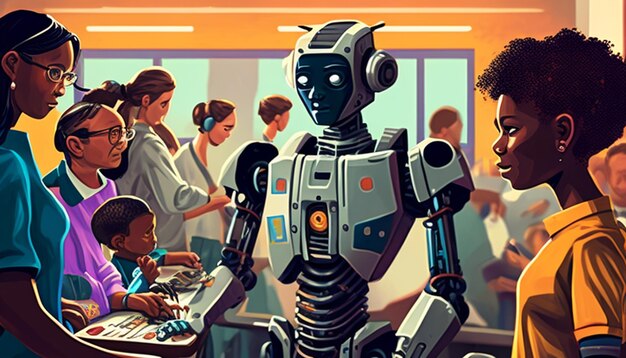Automation’s Impact on US Jobs: Navigating the Future Workforce

The Impact of Automation on the US Workforce: Preparing for the Future of Jobs is a complex issue, influencing job availability across various sectors and requiring strategic adaptation in education, training, and workforce policies to mitigate negative effects and harness new opportunities.
The rise of automation is reshaping the US workforce, presenting both challenges and opportunities. Understanding the impact of automation on the US workforce: preparing for the future of jobs is crucial for workers, businesses, and policymakers alike. This article explores these changes and how to navigate them.
Automation’s Growing Footprint in the US Labor Market
Automation is no longer a futuristic concept; it’s a present-day reality altering industries across the United States. From manufacturing to customer service, machines and algorithms are increasingly performing tasks previously done by humans. This transition is sparking both excitement about increased efficiency and concerns about job displacement.
The Sectors Most Affected by Automation
While automation impacts nearly all sectors, some are more vulnerable than others. Repetitive, rule-based tasks are particularly susceptible. Transportation, manufacturing, and administrative support are experiencing significant changes as automation streamlines operations.
- Manufacturing: Robots and automated systems handle assembly, packaging, and quality control, reducing the need for human labor.
- Transportation: Self-driving vehicles and automated logistics systems are poised to disrupt traditional trucking and delivery services.
- Customer Service: Chatbots and AI-powered virtual assistants are increasingly handling customer inquiries, reducing the need for human agents.

However, automation also creates new opportunities. As machines take over repetitive tasks, humans can focus on more creative, strategic, and interpersonal roles. This shift necessitates a focus on upskilling and reskilling initiatives.
The Upskilling and Reskilling Imperative
As automation reshapes job roles, the need for continuous learning becomes paramount. Upskilling, enhancing existing skills, and reskilling, learning entirely new skills, are essential for workers to remain relevant in the modern job market. Educational institutions, businesses, and government agencies all have a role to play in facilitating this transition.
Government Initiatives for Workforce Development
The government can play a vital role in preparing the workforce for automation by investing in training programs, apprenticeships, and educational resources. Tax incentives for businesses that offer employee training can also encourage upskilling and reskilling efforts.
Community colleges and vocational schools are also offering specialized courses designed to equip workers with the skills needed for in-demand jobs in automated industries. These programs often focus on areas like robotics, data analytics, and cybersecurity.
The Role of Businesses in Employee Training
Companies should view employee training as an investment in their future, not just an expense. By providing opportunities for workers to learn new skills, businesses can ensure they have the talent needed to thrive in an automated world. Internal training programs, online courses, and partnerships with educational institutions are all effective strategies.
The Economic Implications of Automation
Automation has profound economic implications, both positive and negative. While it can boost productivity, lower costs, and drive innovation, it can also exacerbate income inequality and lead to job displacement. Understanding these complex dynamics is crucial for developing effective policies.

Productivity Gains and Economic Growth
Automation can significantly increase productivity by allowing machines to perform tasks more quickly, accurately, and efficiently than humans. This increased productivity can lead to economic growth, higher profits for businesses, and lower prices for consumers.
However, these benefits may not be evenly distributed. If the gains from automation primarily accrue to business owners and shareholders, it can widen the gap between the rich and the poor.
Addressing Income Inequality
To mitigate the negative impacts of automation on income inequality, policymakers can consider a variety of strategies. These include progressive taxation, increased minimum wages, and stronger social safety nets. Investing in education and training can also help ensure that workers have the skills needed to compete in the modern job market.
The Ethical Considerations of Automation
As automation becomes more prevalent, ethical considerations become increasingly important. Issues such as bias in algorithms, data privacy, and the impact on human dignity need to be carefully addressed to ensure that automation is used responsibly and ethically.
Bias in Algorithms
Algorithms are only as good as the data they are trained on. If the data contains biases, the algorithm will likely perpetuate those biases. This can lead to discriminatory outcomes in areas such as hiring, lending, and criminal justice.
- Data Diversity: Ensure training data is representative of the population.
- Algorithm Audits: Regularly audit algorithms for bias.
- Transparency: Promote transparency in algorithm design and implementation.
Data Privacy and Security
Automation often relies on the collection and analysis of vast amounts of data. Protecting the privacy and security of this data is crucial. Robust data protection laws, strong cybersecurity practices, and ethical data governance policies are essential.
The Future of Work: Collaboration Between Humans and Machines
The future of work is not about humans being replaced by machines, but rather about humans and machines working together. By leveraging the strengths of both, businesses can achieve greater levels of productivity, innovation, and efficiency.
Humans excel at tasks that require creativity, critical thinking, and interpersonal skills. Machines excel at tasks that are repetitive, rule-based, and require high levels of accuracy. By combining these strengths, businesses can create more effective and efficient workflows.
Creating a Human-Machine Partnership
Successful human-machine partnerships require careful planning and implementation. Businesses need to identify tasks that are best suited for automation and tasks that are best suited for humans. They also need to provide training and support to help workers adapt to new roles and responsibilities.
Preparing the Next Generation for an Automated World
Preparing the next generation for an automated world requires a fundamental shift in education and training. Schools need to focus on teaching skills that are not easily automated, such as critical thinking, problem-solving, and creativity. They also need to incorporate technology into the curriculum to help students develop digital literacy and technical skills.
- STEM Education: Emphasize science, technology, engineering, and mathematics.
- Digital Literacy: Teach students how to use technology effectively.
- Lifelong Learning: Promote a culture of continuous learning.
In addition to formal education, extracurricular activities such as coding clubs, robotics competitions, and maker spaces can help students develop a passion for technology and a willingness to experiment and innovate. These experiences can also help students develop valuable skills such as teamwork, communication, and problem-solving.
| Key Aspect | Brief Description |
|---|---|
| 🤖 Job Displacement | Automation leads to job losses in routine-based roles. |
| 📚 Upskilling/Reskilling | Essential to adapt to changing job requirements. |
| 💼 Economic Growth | Automation boosts productivity but requires policy adaptations. |
| 🤝 Human-Machine Collaboration | The future involves humans and machines working together. |
FAQ
▼
Automation impacts industries differently. Manufacturing sees increased robot deployment, while customer service relies more on AI chatbots and transportation considers self-driving vehicles.
▼
Essential skills include critical thinking, problem-solving, creativity, and technical knowledge in areas like data analytics, robotics, and cybersecurity to thrive.
▼
Governments can invest in training programs, offer tax incentives for businesses providing skills development and bolster social safety nets to assist displaced workers.
▼
Ethical concerns are paramount and include issues such as algorithmic bias, data privacy, and maintaining human dignity in a heavily automated workforce and society.
▼
Education should emphasize STEM skills, digital literacy, and foster lifelong learning. It should integrate technology to equip students with necessary adaptative skills for future roles.
Conclusion
The impact of automation on the US workforce: preparing for the future of jobs is a multifaceted challenge demanding ongoing adaptation and strategic forward-thinking. By embracing upskilling, addressing ethical considerations, and fostering human-machine collaboration, we can navigate this transformative era successfully, preparing both current and future generations for the evolving landscape of work.





